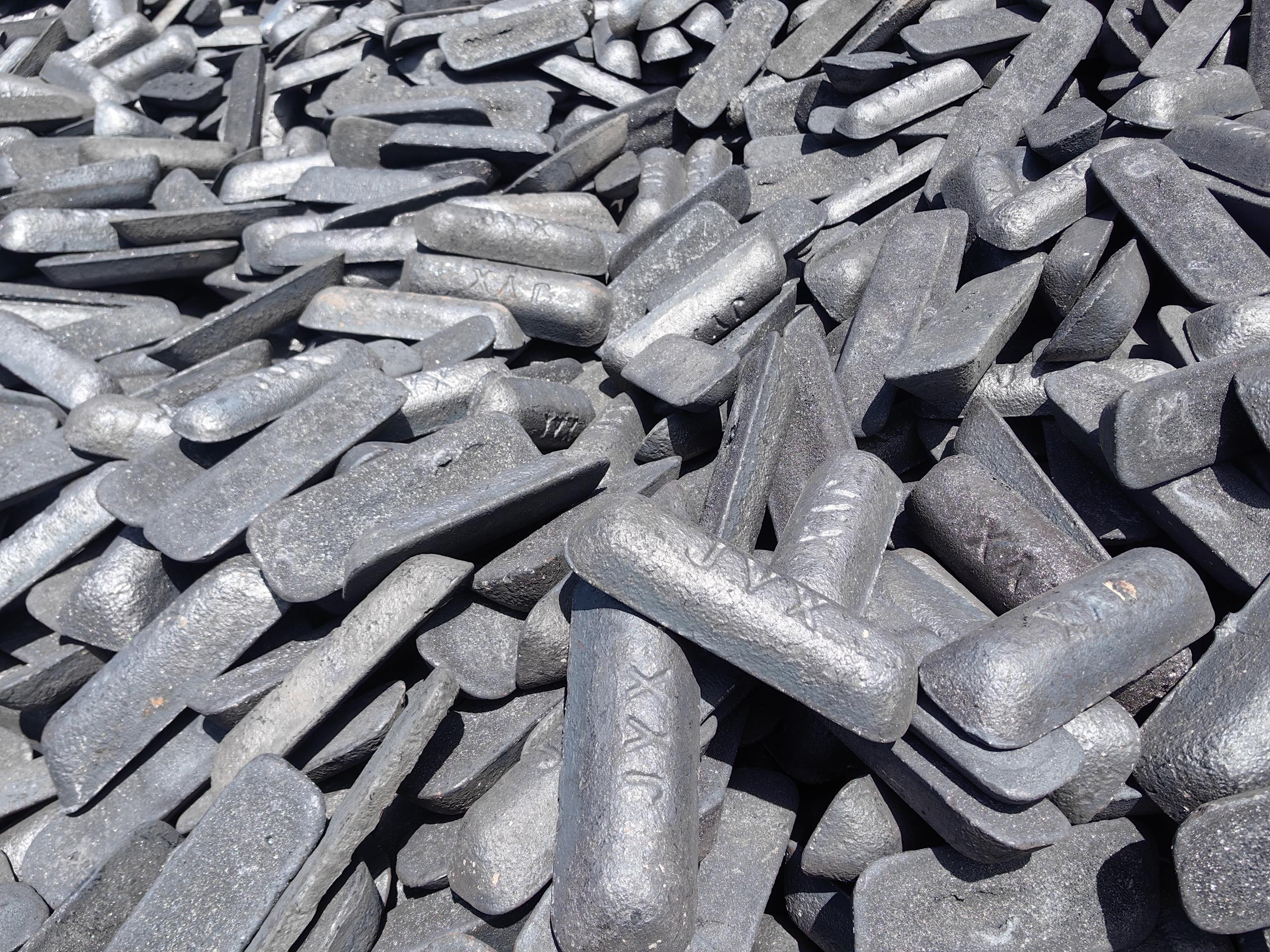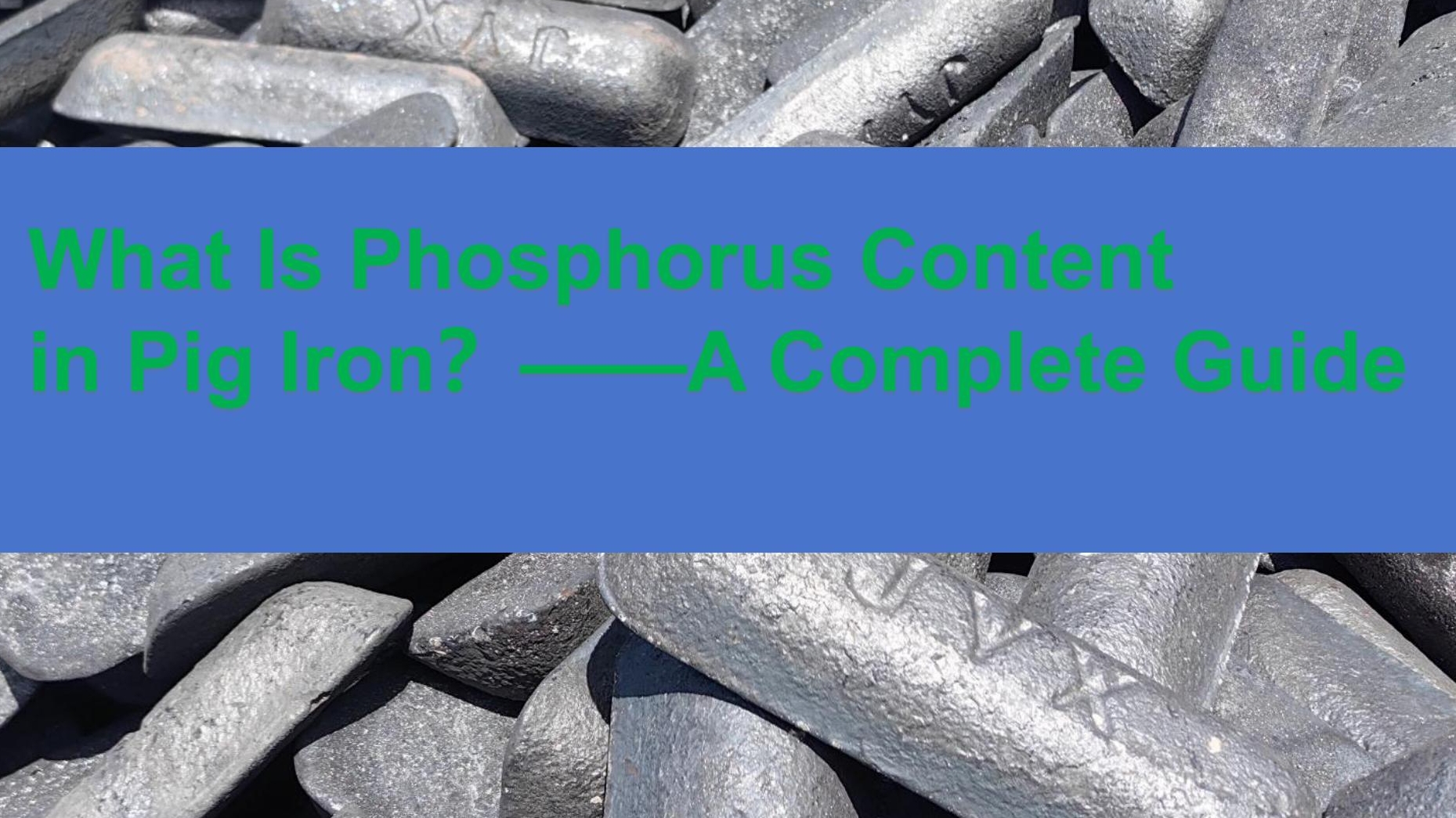How Does Phosphorus Content Affect Pig Iron Quality?——A Complete Guide
2025-08-01 09:58:22 hits:0
Table of Contents
II. The Importance of Phosphorus Content in Pig Iron in the Iron and Steel Industry
III. Determination Methods of Phosphorus Content in Pig Iron
IV. Control and Adjustment of Phosphorus Content in Pig Iron
VI. Future Development Trends of Phosphorus Content in Pig Iron
I. Understanding Phosphorus Content in Pig Iron
(I) Common Definitions
Pig iron is an iron-carbon alloy with a carbon content greater than 2%, and phosphorus is a common impurity element in pig iron. The phosphorus content in pig iron refers to the proportion of phosphorus element in pig iron. It is usually expressed as a mass percentage. For example, when we say that the phosphorus content of a batch of pig iron is 0.05%, it means that in every 100 grams of this pig iron, the mass of phosphorus element is 0.05 grams. The phosphorus content of pig iron produced in different producing areas and by different smelting processes will vary to some extent. In industrial production and quality inspection, accurately determining the phosphorus content of pig iron is crucial for evaluating the quality and performance of pig iron.
(II) Meanings in Different Fields
Iron and Steel Smelting Field
In the process of iron and steel smelting, the phosphorus content of pig iron is a key indicator. Phosphorus in steel will reduce its plasticity and toughness, especially in low-temperature environments, which will cause cold brittleness of steel. Therefore, for most steel products, it is necessary to strictly control the phosphorus content of pig iron. For example, when producing high-strength and high-toughness construction steel, the phosphorus content of pig iron is required to be as low as possible, generally controlled below 0.03% - 0.04%. For some foundry pig iron that does not require high toughness, the control standards for phosphorus content are relatively loose.
Mechanical Manufacturing Field
In mechanical manufacturing, the phosphorus content of pig iron will affect the performance of mechanical parts. If the phosphorus content is too high, the manufactured parts may have brittle fracture during use, reducing the service life and safety of the parts. For example, when manufacturing key components of automobile engines, there are strict requirements on the phosphorus content of pig iron to ensure that the parts can withstand complex mechanical loads.
Chemical Industry Field
In some chemical production processes, the phosphorus content of pig iron will also have an impact. For example, in the production of chemical products such as phosphate fertilizers, it is necessary to consider the recovery and utilization of phosphorus elements in pig iron. If the phosphorus content of pig iron is high, phosphorus can be extracted through specific processes and used in the production of phosphate fertilizers, so as to realize the effective utilization of resources.
II. The Importance of Phosphorus Content in Pig Iron in the Iron and Steel Industry
(I) Impact on Steel Quality
The phosphorus content of pig iron directly affects the quality of steel. As mentioned earlier, phosphorus will reduce the plasticity and toughness of steel, making it prone to cracks and fractures during processing and use. For some high-end steel products, such as aerospace steel and nuclear power steel, the phosphorus content of pig iron is extremely strictly required, even to be controlled below 0.01%. Because these fields have extremely high requirements for the performance of steel, even small fluctuations in phosphorus content may lead to unqualified product quality, thus affecting the safety and reliability of the entire project.
(II) Basis for Adjusting Production Processes
In the steel production process, the phosphorus content of pig iron is an important basis for adjusting the production process. If the phosphorus content of pig iron is too high, special dephosphorization processes need to be adopted to reduce the phosphorus content. For example, in the converter steelmaking process, an appropriate amount of slag-forming agents, such as lime, can be added to make phosphorus elements react with the slag-forming agents to form phosphates, thereby separating phosphorus from the molten iron. At the same time, according to the different phosphorus content of pig iron, it is also necessary to adjust parameters such as steelmaking temperature and time to ensure that the steel products produced meet the quality requirements.
(III) Key Factor in Cost Control
The phosphorus content of pig iron has an important impact on the cost of steel production. On the one hand, the dephosphorization process needs to consume additional raw materials and energy, increasing production costs. If the phosphorus content of pig iron is too high, more resources need to be invested in dephosphorization treatment. On the other hand, high-quality pig iron with low phosphorus content is relatively expensive. Therefore, iron and steel enterprises need to balance the procurement cost of pig iron and the dephosphorization cost, and select pig iron with appropriate phosphorus content as raw materials to achieve effective cost control.
III. Determination Methods of Phosphorus Content in Pig Iron
(I) Chemical Analysis Method
Chemical analysis is a traditional method for determining the phosphorus content of pig iron. This method dissolves the pig iron sample, then uses chemical reactions to convert phosphorus elements into specific compounds, and then determines the content of the compounds through titration, colorimetry and other methods, so as to calculate the phosphorus content of pig iron. For example, the commonly used molybdenum blue colorimetry is to dissolve the pig iron sample, make phosphorus react with ammonium molybdate to form phosphomolybdic heteropoly acid, then reduce it to molybdenum blue with a reducing agent, and determine the absorbance of molybdenum blue by colorimetry, then calculate the phosphorus content. Chemical analysis has the advantages of high accuracy and strong reliability, but the operation process is relatively complex, the analysis time is long, and the technical level of operators is also high.
(II) Spectral Analysis Method
Spectral analysis is a fast and accurate determination method. It uses the absorption, emission and other characteristics of substances to light, and determines the content of phosphorus elements in pig iron by analyzing the spectrum. Common spectral analysis methods include atomic absorption spectrometry and inductively coupled plasma mass spectrometry (ICP-MS). Atomic absorption spectrometry determines the content of phosphorus by measuring the absorption degree of phosphorus element to light of a specific wavelength. ICP-MS has higher sensitivity and accuracy and can determine the content of multiple elements at the same time. Spectral analysis has the advantages of fast analysis speed and simultaneous determination of multiple elements, but the instrument and equipment are expensive and the maintenance cost is high.
(III) Other Methods
In addition to the above two methods, there are some other determination methods. For example, electrochemical analysis uses electrochemical principles to determine the phosphorus content of pig iron, which is simple and fast to operate. In addition, neutron activation analysis can perform non-destructive testing on pig iron samples and can accurately determine the phosphorus content, but this method requires the use of special equipment and has high environmental requirements.
IV. Control and Adjustment of Phosphorus Content in Pig Iron
(I) Control the Phosphorus Content of Raw Materials
To control the phosphorus content of pig iron, we must first start with raw materials. Iron ore is the main raw material for producing pig iron, and the phosphorus content of iron ore from different producing areas is different. When purchasing iron ore, iron and steel enterprises need to strictly test its phosphorus content and select iron ore with low phosphorus content as raw materials. At the same time, for other auxiliary raw materials, such as coke and flux, it is also necessary to control their phosphorus content to reduce the introduction of phosphorus in the smelting process.
(II) Optimize Smelting Processes
In the smelting process, the phosphorus content of pig iron can be reduced by optimizing the process. As mentioned earlier, in the dephosphorization process of converter steelmaking, the dephosphorization efficiency can be improved by reasonably controlling the amount of slag-forming agent added, steelmaking temperature and time and other parameters. In addition, the adoption of advanced smelting processes such as the double-link method can also effectively reduce the phosphorus content of pig iron. The double-link method separates the dephosphorization and decarburization processes of molten iron in different converters, which can better control the phosphorus content.
(III) Adjust Product Formulations
For some products with different phosphorus content requirements, they can be met by adjusting product formulations. For example, when producing different types of steel products, according to the performance requirements of the products, pig iron with different phosphorus contents and other alloy elements can be reasonably matched to achieve the best balance of performance and cost.
V. Impact of Phosphorus Content in Pig Iron on the Market
(I) Price Fluctuations
The phosphorus content of pig iron will affect its market price. Generally speaking, high-quality pig iron with low phosphorus content is relatively expensive because it is more difficult to produce and can meet the needs of high-end steel products. Pig iron with high phosphorus content is relatively low in price and is mainly used in some foundry industries with low quality requirements. The price of pig iron in the market will fluctuate with the change of phosphorus content. When the market demand for low-phosphorus pig iron increases, its price will rise accordingly.
(II) Differences in Market Demand
Different industries have different demands for the phosphorus content of pig iron, resulting in differences in market demand. The high-end steel industry has a large demand for low-phosphorus pig iron, while some ordinary foundry industries have a certain demand for high-phosphorus pig iron. Iron and steel enterprises need to adjust their production strategies according to the differences in market demand and reasonably arrange the production proportion of pig iron with different phosphorus contents to meet the diversified needs of the market.
(III) Impact on International Trade
In international trade, the phosphorus content of pig iron is also an important indicator. Different countries and regions may have different standards for the phosphorus content of pig iron, which will affect the import and export trade of pig iron. Some developed countries have strict requirements on the phosphorus content of imported pig iron. If the phosphorus content of pig iron exported from China does not meet the standards of the other party, it may face trade barriers. Therefore, Chinese iron and steel enterprises need to strengthen the control of phosphorus content in pig iron, improve product quality, and enhance their competitiveness in the international market.
VI. Future Development Trends of Phosphorus Content in Pig Iron
(I) Lower Phosphorus Content Requirements
With the continuous progress of science and technology and the development of industry, the requirements for steel quality are getting higher and higher, and the requirements for phosphorus content in pig iron will be lower and lower in the future. Especially in high-end manufacturing, new energy and other fields, higher challenges are put forward for the performance and quality of steel, requiring pig iron with lower phosphorus content as raw materials. For example, in the manufacture of new energy vehicles, the strength and toughness of steel parts are extremely high, which requires further reduction of phosphorus content in pig iron.
(II) More Advanced Control Technologies
In order to meet the lower phosphorus content requirements, more advanced control technologies for phosphorus content in pig iron will be developed in the future. On the one hand, more efficient phosphorus removal technologies will be adopted in the raw material pretreatment link to reduce the introduction of phosphorus. On the other hand, in the smelting process, more environmentally friendly and energy-saving dephosphorization processes will be developed to improve dephosphorization efficiency and effect. For example, new catalysts and additives are used to accelerate the dephosphorization reaction.
(III) Comprehensive Utilization of Phosphorus Resources
With the increasing shortage of resources, more attention will be paid to the comprehensive utilization of phosphorus resources in pig iron in the future. In addition to using phosphorus for the production of phosphate fertilizers, more ways to utilize phosphorus resources may be developed. For example, phosphorus elements are applied to the research and development of new materials to maximize the utilization of resources.
In conclusion, the phosphorus content of pig iron has a wide range of applications and important roles in the iron and steel industry and related fields. Whether in steel quality control, production process adjustment, or market supply and demand and international trade, it is necessary to pay close attention to the phosphorus content of pig iron. With the continuous development of technology, the control and application of phosphorus content in pig iron will continue to innovate and progress. We need to keep up with these trends to make better use of pig iron resources and promote the development of related industries.
If you want to master the comprehensive knowledge of carbon, silicon, manganese, phosphorus, and sulfur at once, the summary blog "Comprehensive Analysis of Pig Iron Parameters" will be a good choice.
We have conducted special analyses for each element in pig iron. For more details, you can click directly to view: [Carbon in Pig Iron], [Silicon in Pig Iron], [Manganese in Pig Iron], [Phosphorus in Pig Iron], [Sulfur in Pig Iron].
If you have any thoughts, please feel free to contact us for communication.
You can also share this article with more friends who are interested in the chemical composition of pig iron.
About Tiegu Company
As a professional pig iron supplier, Tiegu Company covers various types such as steel-making pig iron, foundry pig iron, ductile iron, and high-purity iron, which can meet the diversified needs for manganese content in different scenarios. Through strict detection of raw material manganese content, real-time monitoring and precise adjustment during production, the company ensures stable product quality and provides customers with reliable pig iron supply solutions.
Contact Us
WhatsApp: 15256135588 (First 10 inquiries receive extra gifts)
E-mail:zbw@tiegu.net
Apply for Pilot: Click the link to get a customized solution (First batch of customers enjoy 20% discount)
Blog Author Profile
DAWN | Pig Iron & Castings Procurement Advisor 18 years in the foundry trenches give me an edge: I know how pig iron’s chemistry impacts casting quality and can troubleshoot defects like cracks and porosity. With a 1M MT/year pig iron and 60k MT/year casting output from our in-house factory, plus 200+ verified suppliers on our platform, we offer fast price comparisons. Expect a 24-hour inquiry response—my goal? Not just closing deals, but being your go-to partner in the foundry world.
18 years in the foundry trenches give me an edge: I know how pig iron’s chemistry impacts casting quality and can troubleshoot defects like cracks and porosity. With a 1M MT/year pig iron and 60k MT/year casting output from our in-house factory, plus 200+ verified suppliers on our platform, we offer fast price comparisons. Expect a 24-hour inquiry response—my goal? Not just closing deals, but being your go-to partner in the foundry world.


 en
en  fra
fra  de
de  ru
ru  ara
ara  gle
gle  it
it  jp
jp  kor
kor  th
th  zh
zh 



